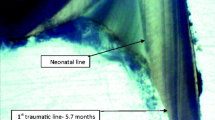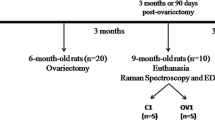Abstract
Few reports are available in the literature on enamel formation under nutritional deficiencies. Thus, we performed a study to determine the effects of boron (B) deficiency on the maturing dental enamel, employing the rat continuously erupting incisor as the experimental model. Male Wistar rats, 21 days old, were used throughout. They were divided into two groups, each containing ten animals: +B (adequate; 3-mg B/kg diet) and −B (boron deficient; 0.07-mg B/kg diet). The animals were maintained on their respective diets for 14 days and then euthanized. The mandibles were resected, fixed, and processed for embedding in paraffin and/or methyl methacrylate. Oriented histological sections of the continuously erupting incisor were obtained at the level of the mesial root of the first molar, allowing access to the maturation zone of the developing enamel. Dietary treatment did not affect food intake and body weight. Histomorphometric evaluation using undecalcified sections showed a reduction in enamel thickness (hypoplasia), whereas microchemical characterization by energy-dispersive X-ray spectrometry did not reveal alterations in enamel mineralization.







Similar content being viewed by others
References
Hu JC, Chun YH, Al Hazzazzi T, Simmer JP (2007) Enamel formation and amelogenesis imperfecta. Cells Tissues Organs 186:78–85
Nanci A (2008) Ten Cate's oral histology: development, structure, and function, 7th edn. Mosby, St. Louis
Warshawsky H, Smith CE (1974) Morphological classification of rat incisor ameloblasts. Anat Rec 179:423–446
Smith CE, Nanci A (1989) A method for sampling the stages of amelogenesis on mandibular rat incisor using the molars as a reference for dissection. Anat Rec 225:257–266
Simmer JP, Fincham AG (1995) Molecular mechanisms of dental enamel formation. Crit Rev Oral Biol Med 6:84–108
Smith CE (1998) Cellular and chemical events during enamel maturation. Crit Rev Oral Biol Med 9:128–161
Smith CE, Chong DL, Bartlett JD, Margolis HC (2005) Mineral acquisition rates in developing enamel on maxillary and mandibular incisor of rats and mice: implications to extracellular acid loading as apatite crystals mature. J Bone Miner Res 20:240–249
Nanci A, Smith CE (1992) Development and calcification of enamel. In: Bonucci E (ed) Calcification in biological systems. CRC, Boca Raton, pp 313–343
Smith CE, Warshawsky H (1975) Cellular renewal in the enamel organ and the odontoblast layer of the rat incisor as followed by radioautography using 3H-thymidine. Anat Rec 183:523–561
Punyasingh JT, Hoffman S, Harris SS, Navia JM (1984) Effects of vitamin A deficiency on rat incisor formation. J Oral Pathol 13:40–51
Cerklewski FL (1981) Effect of suboptimal zinc nutrition during gestation and lactation on rat molar tooth composition and dental caries. J Nutr 111:1780–1783
Lozupone E, Favia A (1989) Effects of a low calcium maternal and weaning diet on the thickness and microhardness of rats incisor enamel and dentine. Arch Oral Biol 34:491–498
Lozupone E, Favia A (1994) Morphometric analysis of the deposition and mineralization of enamel and dentine from rat incisor during the recovery phase following a low-calcium regimen. Arch Oral Biol 39:409–416
Bonucci E, Lozupone E, Silvestrini G, Favia A, Mocetti P (1994) Morphological studies of hypomineralized enamel of rat pups on calcium-deficient diet, and of its changes after return to normal diet. Anat Rec 239:379–395
Nanci A, Mocetti P, Sakamoto Y, Kunikata M, Lozupone E, Bonucci E (2000) Morphological and immunocytochemical analyses on the effects of diet-induced hypocalcemia on enamel maturation in the rat incisor. J Histochem Cytochem 48:1043–1058
Wessinger GD, Weinmann JP (1943) The effect of manganese and boron compounds on the rat incisor. J Physiol 139:233–238
Devirian TA, Volpe SL (2003) The physiological effects of dietary boron. Crit Rev Food Sci Nutr 43:219–231
Nielsen FH (2008) Is boron nutritionally relevant? Nutr Rev 66:183–191
Chapin RE, Ku WW, Kenney MA, McCoy H (1998) The effect of boron on bone characteristics and plasma lipids in rats. Biol Trace Elem Res 66:395–399
Nielsen FH (2000) The emergence of boron as nutritionally important throughout the life cycle. Nutrition 16:512–514
Nielsen FH (2000) Importance of making dietary recommendations for elements designated as nutritionally beneficial, pharmacologically beneficial, or conditionally essential. J Trace Elem Exp Med 13:113–129
Nielsen FH (2004) Dietary fat composition modifies the effect of boron on bone characteristics and plasma lipids in rats. Biofactors 20:161–171
Gallardo-Williams MT, Maronpot RR, Turner CH, Johnson CS, Harris MW, Jayo MJ, Chapin RE (2003) Effects of boric acid supplementation on bone histomorphometry, metabolism, and biomechanical properties in aged female F-344 rats. Biol Trace Elem Res 3:155–169
Naghii MR, Tarkaman G, Mofid M (2006) Effects of boron and calcium supplementation on mechanical properties of bone in rats. Biofactors 28:195–201
Gorustovich A, Steimetz T, Nielsen FH, Guglielmotti MB (2008) A histomorphometric study of alveolar bone healing in rats fed a boron-deficient diet. Anat Rec 291:441–447
Gorustovich A, Steimetz T, Nielsen FH, Guglielmotti MB (2008) A histomorphometric study of alveolar bone modeling and remodeling in mice fed a boron-deficient diet. Arch Oral Biol 53:677–682
Hunt CD (1996) Dietary boron deficiency and supplementation. In: Watson RR, Wolinsky I (eds) Methods in nutrition research. CRC, Boca Raton, pp 229–253
Hunt CD (1996) Biochemical effects of physiological amounts of dietary boron. J Trace Elem Exp Med 9:185–213
Bakken NA, Hunt CD (2003) Dietary boron decreases peak pancreatic in situ insulin release in chicks and plasma insulin concentrations in rats regardless of vitamin D or magnesium status. J Nutr 133:3577–3583
Frost HM (1960) Presence of microscopic cracks in vivo in bone. H Ford Hosp Med Bull 8:25–35
Burr DB, Stafford T (1990) Validity of the bulk-staining technique to separate artifactual from in vivo bone microdamage. Clin Orthop Rel Res 260:305–308
Warshawsky H (1971) A light and electron microscopic study of the nearly mature enamel of rat incisors. Anat Rec 169:559–584
Smith CE, Nanci A (1995) Overview of morphological changes in enamel organ cells associated with major events in amelogenesis. Int J Dev Biol 39:153–161
Clarkson J (1989) Review of terminology, classifications, and indices of developmental defects of enamel. Adv Dent Res 3:104–109
Seow WK (1991) Enamel hypoplasia in the primary dentition: a review. ASDC J Dent Child 58:441–452
Oliveira AF, Chaves AM, Rosenblatt A (2006) The influence of enamel defects on the developmental of early caries in a population with low socioeconomic status: a longitudinal study. Caries Res 40:296–302
Sasaki T, Debari K, Garant PR (1987) Ameloblast modulation and changes in the Ca, P, and S content of developing enamel matrix as revealed by SEM–EDX. J Dent Res 66:778–783
Arnold WH, Gaengler P (2007) Quantitative analysis of the calcium and phosphorus content of developing and permanent human teeth. Ann Anat 189:183–190
Torrisi L, Rapisarda E, Cicero G (1989) Boron in dental hard tissues studied by 11B(p,α)8Be nuclear reaction. Minerva Stomatol 38:935–940
Shashikiran ND, Subba Redy VV, Hiremath MC (2007) Estimation of trace elements in sound and carious enamel of primary and permanent teeth by atomic absorption spectrophotometry: an in vitro study. Indian J Dent Res 18:157–162
Losee FL, Ludwig TG (1970) Trace elements and caries. J Dent Res 49:1229–1235
Curzon MEJ, Adkins BL, Bibby BG, Losee FL (1970) Combined effect of trace elements and fluorine on caries. J Dent Res 49:526–528
Curzon MEJ (1983) Combined effect of trace elements and fluorine on caries: changes over ten years in Northwest Ohio (USA). J Dent Res 62:96–99
Liu FTY (1975) Postdevelopmental effects of boron, fluoride, and their combination on dental caries activity in the rat. J Dent Res 54:97–103
Elsair J, Merad R, Denine R, Reggabi M, Benali S, Assouz M, Khelfat K, Aoul MT (1980) Boron as an antidote in acute fluoride intoxication in rabbits: its action on the fluoride and calcium–phosphorus metabolism. Fluoride 13:30–38
Acknowledgements
This study was supported by the US Department of Agriculture, Agriculture Research Service USDA, ARS Extramural Agreement 58-5450-4N-F038.
The authors wish to acknowledge the technical assistance of Jim Lindlauf (USDA ARS, Grand Forks Human Nutrition Research Center) for animal diet preparation, Lic. Pablo Do Campo (IByME-CONICET) with confocal laser scanning microscopy, and Ing. Pedro Villagrán (LASEM–ANPCyT–UNSa–CONICET) with SEM–EDS.
Author information
Authors and Affiliations
Corresponding author
Rights and permissions
About this article
Cite this article
Haro Durand, L.A., Mesones, R.V., Nielsen, F.H. et al. Histomorphometric and Microchemical Characterization of Maturing Dental Enamel in Rats Fed a Boron-Deficient Diet. Biol Trace Elem Res 135, 242–252 (2010). https://doi.org/10.1007/s12011-009-8512-9
Received:
Accepted:
Published:
Issue Date:
DOI: https://doi.org/10.1007/s12011-009-8512-9




